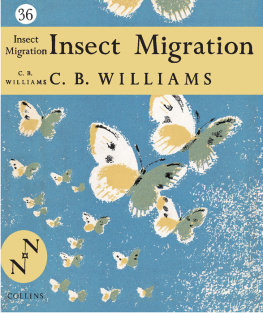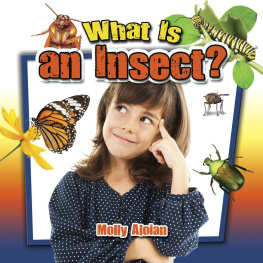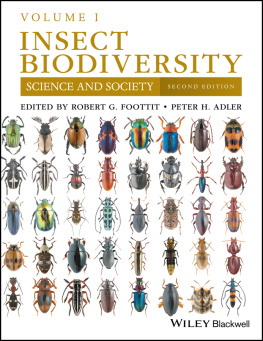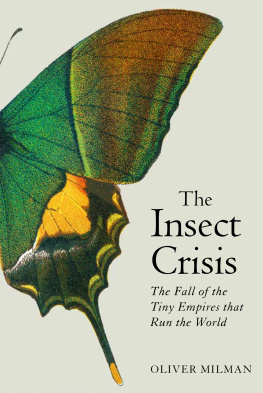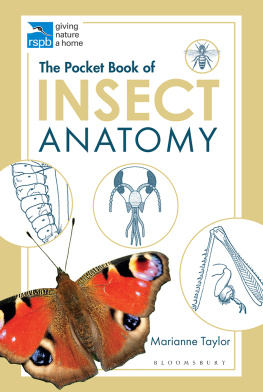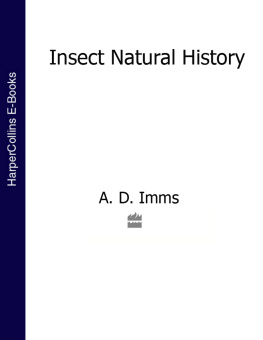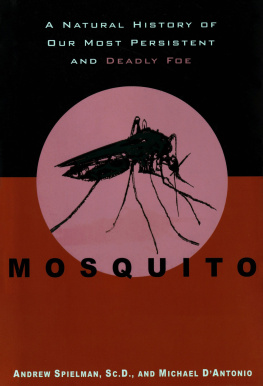
JOHN GILMOUR, M.A., V.M.H.
SIR JULIAN HUXLEY, M.A., D.Sc., F.R.S.
MARGARET DAVIES, M.A., Ph.D.
KENNETH MELLANBY, C.B.E., Sc.D.,
PHOTOGRAPHIC EDITOR:
ERIC HOSKING, F.R.P.S.
The aim of this series is to interest the general reader in the wild life of Britain by recapturing the inquiring spirit of the old naturalists. The Editors believe that the natural pride of the British public in the native fauna and flora, to which must be added concern for their conservation, is best fostered by maintaining a high standard of accuracy combined with clarity of exposition in presenting the results of modern scientific research. The plants and animals are described in relation to their homes and habitats and are portrayed in the full beauty of their natural colours by the latest methods of colour photography and reproduction
To Mr WIFE whose co-operation has made this book and many other things possible
W HEN the author of this book was a boy, the fact that large numbers of insects undertake migratory movements almost as remarkable as those of birds was unknown to all but a few observers. Even today the widespread distribution of the migratory habit throughout the insect world is fully recognised by a handful of scientists and skilful amateurs. Only in recent years has the significance of all sorts of interesting and absorbing facts been appreciatedyet the facts have been before naturalists eyes almost since naturalists began.
C. B. Williams has been interested in the migration of insects for nearly half a century. He was a great pioneer, a devoted worker in a subject that was once almost his alone.
This is a particularly happy book for the New Naturalist to publish since it makes the best of two worldsBritain, and the world at largeonly one of which is the normal province of the New Naturalist. We refer to the fact that the strict speciality of our series is the natural history of the British Isles. There are many fields of natural history which were pioneered in our islands, and many more that were pioneered by British naturalists. But not often can Britain be said to be the peg on which a biological problem belonging to the whole world can be hung properly.
The truth is that at present British material must be the mainstay of any book on insect migration as a general problem. British observations of the movements of insects are more abundant, more continuous and date back longer than those of any other country. Britain is the home of the development of the present theories of insect migration, and is also the headquarters of the main research organisation for the study of locusts. We have here a masterly summary of the extent of human knowledge on a world problem which is, at the same time, in essence, a book on British natural history.
In this distillation of his lifes work Dr. Williams has given us an up-to-date assessment of present knowledge of the subject. It will probably be found that there are members of every order of winged insects which migrate, though so far observation has largely been concentrated upon butterflies and moths, dragonflies, some beetles and two-winged flies, and the locusts.
As Dr. Williams recounts it the awakening of human consciousness of the extent to which insects migrate has been a slow and patchy story. In this story (we should underline, for he does not), his own personal observations and adventures in many parts of the world have played an important and fundamental part. Almost can this book be said to be a world detective story. Certainly some of the incidents and discoveries recounted in it must be as thrillng to the naturalist as any complicated piece of detection is to the reader of crime novels. The detective simile can usefully stay with us, for Dr. Williams has arranged his argument, his definitions and the steps of his discussion, with the inexorable tactics of the skilled, practical and philosophical investigator. He says, himself, that it is easy to make theories but difficult to find any that will fit the facts, all the facts and nothing but the facts. He marshals and summarises his own theories with modesty, economy and skill, and in a fine scientific spirit of dissatisfaction. This book is a pioneer book, a real milestone in the progress of biology. We are honoured to publish what will certainly prove to be, above all things, the stimulus for new search, exciting discoveries and interesting conclusions.
Dr. Williams career as a professional entomologist began in 1911, after he had graduated from Cambridge, at the John Innes Horticultural Institution in Surrey. After wide experience of economic entomology in Trinidad, Egypt and Tanganyika, during which he lost no opportunity to collect completely new information on the movements of insects, he joined the staff of Edinburgh University in 1929 as Lecturer in Agricultural and Forest Zoology.
After a visit to the University of Minnesota, U.S.A. as Guest Professor he became in 1932 chief entomologist to Rothamsted Experimental Station, where he remained till 1955. During the war, in 194344 he visited most of the countries in South America as a scientific liason officer for the British Council. In 1954 he was elected a Fellow of the Royal Society for pioneer work in two fields of biology, the migration of insects and the application of statistical methods to the study of insect populations. Since he retired from Rothamsted he has lived in the highlands of Inverness-shire working, on behalf of the Agricultural Research Council, on the relation of insect abundance to weather conditions.
THE EDITORS
I STARTED to collect insects when I was about twelve years old and, with encouragement at home, kept up my interest during school and university days. Throughout this period I had heard rumours of butterflies occasionally crossing the Channel from France to England, and also knew of the controversy about distinguishing, by the colour of the border, real British Camberwell Beauties from the worthless Continental specimens. There was, however, very definitely fixed in my mind the impression that insects were sedentary; that they kept very close to the spot where they had fed as caterpillars; and that individuals which wandered more than a few miles were quite exceptional and belonged to very few species. After all, the collectors world was full of localities, some only a few acres in extent, to which one went to find rarities. Entomologists came all the way to the coast sandhills of Cheshire, which was my home, to collect Belted-Beauties; and one of my chief reasons for wishing to go to the University of Cambridge was that our only British Swallow-tail butterfly was confined to Wicken and some other relatively small areas in the neighbouring fenlands of East Anglia.
In 1916 my horizon was suddenly widened by my appointment in the Colonial Service as an agricultural entomologist in the West Indies. In August of this year I was searching for beneficial insects on an abandoned rubber estate in the backwoods of British Guiana. One day I noticed numbers of yellow butterflies crossing the garden of the house where I was staying, and after a few minutes I realised that all were flying steadily in one directiontowards the south-east.
As will be seen later, such flights had been known for a hundred years or more, but this was the first that had ever come my way.
The flight continued steadily for several days and I was able to trace the butterflies across low-lying rivers and forest land over a front of about ten miles. I then questioned people who had lived in the country and found that many had observed similar flights; some even said that they were of regular occurrence. I still, however, mentally filed such movements as rare events, and considered myself lucky to have seen one. Nevertheless, in the course of my next few years wanderings in this part of the world, I saw in Trinidad a much larger flight which lasted for over two weeks, and several smaller flights here and also in Costa Rica.
Next page
